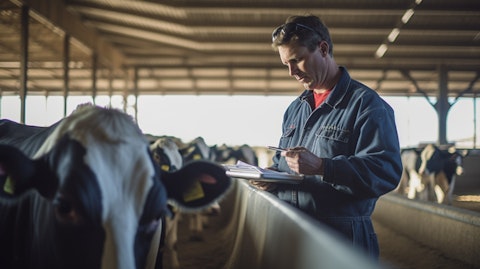ImmuCell Corporation (NASDAQ:ICCC) Q3 2025 Earnings Call Transcript November 14, 2025
Operator: Good morning, and welcome to the ImmuCell Corporation Reports Third Quarter ended September 30, 2025, Unaudited Financial Results Conference Call. [Operator Instructions] Please note, this event is being recorded. I would now like to turn the conference over to Joe Diaz of Lytham Partners. Please go ahead.
Joe Diaz: Thank you, Rocco. Good morning, and welcome to everyone. As Rocco indicated, my name is Joe Diaz with Lytham Partners. We’re the Investor Relations consulting firm for ImmuCell. I want to thank all of you for joining us today to discuss the unaudited financial results for the third quarter ended September 30, 2025. Listeners are cautioned that statements made by management during the course of this call include forward-looking statements, which include any statements that refers to the future events or expected future results or predictions about steps the company plans to take in the future. These statements are not guarantees of performance and are subject to risks and uncertainties that could cause actual results, outcomes or events to differ materially from those discussed today.
Additional information regarding forward-looking statements and the risks and uncertainties that could impact future results, outcomes or events is available under the cautionary note regarding forward-looking statements better known as the safe harbor statement provided with the Form 10-Q and the press release that the company filed last night, along with the company’s other periodic filings with the SEC. Information discussed on today’s call speaks only as of today, Friday, November 14, 2025. The company undertakes no obligation to update any information discussed on today’s call. Please note that references to certain non-GAAP financial measures may be made during today’s call. The company included definitions of these terms as well as reconciliations of these figures to the most comparable GAAP financial measures in last night’s press release in order to better assist you in understanding its financial performance.
With that said, let me turn the call over to Michael Brigham, Special Adviser to the CEO of ImmuCell Corporation for opening remarks. Michael?
Michael Brigham: Thanks, Joe, and good morning, everyone. This is an exciting time at ImmuCell. Lots of good change going on. Our financial performance over the first 9 months of 2025 has greatly improved compared to prior year, a turnaround, which was made possible in part by increasing our production output while improving gross margins. We are now in a great position as a company with a stock distribution channel and an energized commercial team. Our CEO and CFO will be commenting on the financial results in greater detail in just a moment. On another topic of change, we are amidst 2 very positive management transitions right now at ImmuCell. First, as most of you know by now, we added Timothy Fiori, our CFO, to the team back in April.
Secondly, back in June, we announced the CEO succession plan. This effort was completed successfully effective November 1, 2025, with the hiring of Olivier Te Boekhorst as our new President and CEO. I’d like to welcome Olivier to the company. Olivier brings over 25 years of leadership and results-focused execution experience in animal health to ImmuCell. Before joining ImmuCell, he served as an operating partner of ARCHIMED, a global health care investment firm, where he focused on Animal Health Investments and served as Chairman and Chief Executive Officer of a portfolio company. Prior to that, Mr. Te Boekhorst was at IDEXX for 18 years, IDEXX is a main-based NASDAQ listed company with more than $4 billion in revenue, where Olivier lead strategy and M&A activities from 2004 to 2008 and then served as a Corporate Officer, Senior Vice President and General Manager of several business units from 2008 to 2021, including their livestock and dairy antibiotic residue testing businesses.
He has a track record of driving growth and operational excellence in the livestock industry. And as I step away in January after 36 years with ImmuCell, I am very confident that we are in good hands with Olivier and Tim. At this point, I will turn the call over to Olivier for a few comments. Olivier?
P. F. Te Boekhorst: Thanks, Michael. I am very excited to be here, and I want to thank you for your support during my onboarding. I appreciate the warm welcome and the investment from employees in my onboarding process over the last 2 weeks as I’m starting to learn the business. In conversations with the team, I’ve been asked why I joined ImmuCell. And one of the reasons for my excitement to join at this juncture is the importance of the work here. Fundamentally, ImmuCell keeps cats alive and healthy. We don’t just make and sell doses of First Defense. We provide protection to newmored animals that cannot protect themselves. Farmers trust us because our technology works and they count on us to help them do their jobs better.
And I tell the team that starts with the care and the effort we all put in every day. It is impressive to see the passion, dedication and pride of our staff in Maine and in the field as we support the larger mission of reducing the use of antibiotics in the food supply chain and ensuring the availability of safe, healthy and affordable dairy and beef products. I look forward to the next weeks of my onboarding process as I plan to spend a good deal of time in the field meeting customers, colostrum suppliers, distributor partners, key opinion leaders and the commercial team. I’m a customer-focused leader, and I intend to bring customer perspectives to everything we do at ImmuCell. ImmuCell is poised to do great things, and I’m very excited to be a part of that.
The company aims to deliver a strong value proposition for farmers and our financial and operational performance so far in 2025 reflects that. Execution across our supply chain will be laser-focused on quality and product availability from vaccine production, colostrum sourcing, liquid processing, formulation, packaging and shipping of final products, our team is rebuilding confidence in the market and our ability to consistently meet customers’ needs. I look forward to working, to regain customers, to capture share and to expand the use of scours preventatives. It’s an exciting time to be at ImmuCell as we explore new market opportunities more aggressively. Now turning to our revenue for the quarter. We had an 8% decrease in total product sales during the third quarter of 2025 compared to the third quarter of the prior year.
This is in line with previous comments we made about the effect of restocking our distribution channels earlier this year. I’m encouraged that domestic sales were up 2% during the third quarter compared to the third quarter of 2024, and domestic sales were up 9.5% during the third quarter compared to the second quarter of 2025. So we are seeing positive momentum in the U.S. market that represented about 86% of our sales during the trailing 12-month period ended in September 30, 2025. International sales, largely to Canada, were down during the third quarter of 2025 compared to the third quarter of 2024 due to timing of shipments and allocations of our short supply while we’re managing our order backlog. This did create the 8% decrease in total sales during the third quarter that I just mentioned, but I do not believe this represents significant deterioration of underlying customer demand.

It is worth noting that international sales during the 9-month period ended September 30, 2025, were 15% higher than the same period of the prior year. Longer-term growth trends are also meaningful. When we compare our trailing 12-month sales ending September 30, 2025, to the same period ending September 30, 2022, that is the period before we ran into significant supply issues, the 3-year compound annual growth rate is 11%. Okay. Turning to net income. We delivered net income of $1.8 million during the 9 months ended September 30, 2025, compared to a net loss of $2.7 million during the 9 months ended September 30, 2024, which is a $4.5 million swing in the right direction, driven by a significant improvement in gross margins that Tim will discuss in detail.
We are focused on production capacity and quality, and one way to measure that is the approximate level of revenue we can now support. During the 9 months ended September 30, 2025, we demonstrated that we can produce at an annual rate that is very close to our capacity expansion goal of $30 million per year. Our priority now is on operational excellence and execution while we review our next capacity expansion opportunities. At this point, I’m going to turn the call over to Timothy Fiori, our Chief Financial Officer, for a deeper review of the third quarter financial highlights. Tim was my finance leader at IDEXX for 15 years, and it is a pleasure to team up with him again here at ImmuCell. Tim?
Timothy Fiori: Thanks, Olivier. I’m happy to be working with you again. To start, I’d like to focus on improvements we’ve seen regarding the year-to-date net income and earnings per share as compared to prior year. Net income during the 9-month period ended September 30, 2025, increased by $4.5 million over the net loss during the 9-month period ended September 30, 2024. This significant improvement was driven by higher sales with increased gross margins and a 7.4% or $543,000 reduction in operating expenses. Basic net income per share during the 9-month period ended September 30, 2025, was approximately $0.20 per share in contrast to a net loss of $0.34 per share during the same period of the prior year. As Olivier mentioned in his comments, product sales during the third quarter of 2025 decreased by 8% or $505,000 compared to the third quarter of 2024.
Product sales during the 9-month period ended September 30, 2025, increased by 7% or $1.3 million over the 9-month period ended September 30, 2024. Product sales during the trailing 12-month period ended September 30, 2025, increased by 16% or $3.9 million over the trailing 12-month period ended September 30, 2024. During the first half of the year, we effectively eliminated our backlog of orders and rebuilt inventory and distribution. Refilling the distribution pipeline after an extended backlog provided a temporary boost to sales. Overall, I’m pleased that we are out of the prior order backlog situation. As we can see in the Q3 results, backlog dynamics have created difficult conditions for year-over-year sales comparisons. During the Q2 call, we anticipated that we may experience a softening in sales during the second half of 2025, and that has happened as predicted in Q3.
We believe that difficult comparisons may persist due to the backlog fulfillment in prior periods for the next several quarters. We should lap this backlog dynamic in the second half of 2026, given that we effectively exited the backlog situation as of June 30, 2025. You can see prior year backlog information by quarter in our most recent 10-K and in the 10-Q that we just filed. We have realized gross margin improvements in 2025 as compared to the prior year. Gross margin as a percentage of product sales increased to 43% during the third quarter of 2025 compared to just 26% during the third quarter of 2024. Gross margin increased to 43% during the 9-month period ended September 30, 2025, compared to just 27% during the 9-month period ended September 30, 2024.
Gross margin increased to 41% during the 12-month period ended September 30, 2025, compared to just 27% during the trailing 12-month period ended September 30, 2024. Future success will require continued achievement of strong production yields, coupled with strong sales growth. We have several opportunities to drive growth from the existing products, including regaining customers that we may have lost during the short supply in years past. We also have several new product offerings in our functional feed product line. I’d like to talk for a moment about adjusted EBITDA because the impact of noncash depreciation expense on our bottom line is significant. To be clear, adjusted EBITDA includes an add-back of stock-based compensation expense, which is another noncash expense that’s included in net income as calculated in accordance with GAAP.
We created adjusted EBITDA of $751,000, $4.4 million and $5.8 million during the 3-month, 9-month and trailing 12-month periods ended September 30, 2025, respectively. These strong results compare favorably to adjusted EBITDA of $196,000, $35,000 and negative $175,000 during the 3-month, 9-month and trailing 12-month periods ended September 30, 2024, respectively. These strong results helped us increase cash to $3.9 million as of September 30, 2025, from $3.8 million as of December 31, 2024, while investing about $2.7 million in inventory build as we approach peak selling season. We will continue to closely monitor and manage cash as we balance long-term investment with near-term operational needs. With that, I will turn the call back to Olivier for some closing remarks.
Olivier?
P. F. Te Boekhorst: Thanks, Tim. We are very focused on the commercial opportunity that we have with the First Defense suite of solutions, including the new products within the functional feed line that were launched in June. There is tremendous runway for First Defense, and we are excited to come out of a supply-constrained environment to execute growth initiatives. The energy in the commercial team is palpable. We are also very focused on operational excellence to ensure consistent supply of quality product. The year-over-year improvement in adjusted EBITDA that Tim just touched on are the results of this focus with increased sales at better gross margin and lower operating expenses. As we discussed before, we are awaiting FDA approval for our Re-Tain product, which addresses an important market need for effective treatment of subclinical mastitis.
We believe that treating subclinically infected cows with Re-Tain could enhance best practices in the industry with an alternative to traditional antibiotics that are also used in human medicine. While we wait for FDA approval, we have started investigational product use studies to collect market feedback about product performance in the field in collaboration with Michigan State University. These studies are well underway, and the data we gather from this work will inform us of our best strategies for Re-Tain in 2026. This disciplined approach is intended to support a successful market entry. Our top priority at ImmuCell will be on solid execution across the organization. And I’m very pleased that we can leverage the foundation that Michael and the team have rebuilt and that we can now set our sights on defining and executing our strategy for long-term growth.
With that said, we will be happy to take your questions. Let’s have the operator open up the lines.
Q&A Session
Follow Immucell Corp (NASDAQ:ICCC)
Follow Immucell Corp (NASDAQ:ICCC)
Receive real-time insider trading and news alerts
Operator: [Operator Instructions] And our first question today comes from Frank Gasca, private investor.
Frank Gasca: First of all, and I want to thank Mike for his service, for the years that he put in at ImmuCell, and we go back quite a way, it’s about 25 years. So I wish him well in his upcoming retirement as I enjoy mine. As far as my questions, I’m going to take a somewhat more critical turn. I don’t see the clean slate that you referred to. I see more — in regards to First Defense, what has changed? It went from an expansion of capacity. We even committed capital, and now we’re uncommitted to that expansion. I think you touch some of the causes of that. But what I’m looking for is what active and steps are you taking to increase that growth that was somewhat anticipated even years ago.
P. F. Te Boekhorst: Thank you, Frank, for your question. And let me maybe just start with — what we mentioned is we are now at a level of capacity that we set out for ourselves when we started the capacity expansion project a few years ago. And while we had a contamination event, we have now arrived at a place where we are actually in a better shape than we even were when we started that capacity expansion project because we have put all kinds of quality measures in place to ensure that we can manufacture at a predictable level. So that is an improvement in our capability. What I’m very excited to report after my first few calls with the commercial team is that after years of managing short supply, they are now able to go win new customers, talk to customers about increasing the use of First Defense if they’re already using it.
And this is a very different approach that the commercial team can now engage with, and they are very excited. I will be visiting the field next week with — visiting with customers. And hopefully, we’ll be able to report back to you firsthand what that excitement at both the customer and the sales team level is. So we’re very pleased to be where we are. There is more to do but it does look quite positive from where I’m sitting. Thank you for your question.
Operator: [Operator Instructions] Our next question comes from George Melas with MKH Management.
George Melas: Thanks. First of all, I sort of want to reiterate what the previous caller said. Michael, thank you very much for your service and we appreciate it working with you. And I just want to say thank you very much. Olivier, welcome to the team. It’s very exciting to have you. My question is a bit about the inventory. The WIP continues to grow. I mean a lot of it is the frozen colostrum, which is, I think we report is $3.3 million. But the finished good inventory right now stands at $2 million, which is the highest it’s been, I think, in probably 6, 7 or maybe ever or at least from my model in at least 6 years. I’m trying to see and — trying to see how you plan to balance sort of production with sort of cash generation or cash management.
P. F. Te Boekhorst: Well, first, George, thank you very much for your welcome. I’m going to turn it over to Tim to address the inventory question.
Timothy Fiori: George, good to talk with you. Yes, we definitely have seen inventory levels come up a lot. Of course, we started the year with really practically nothing, and now we have a more desirable level, frankly, of inventory and especially as we approach the peak selling season that’s coming up in the — around the first quarter. I meet with the team weekly with sales and the production team personally, and we have a good communication between the 2, and we do a planning process to seek those desired inventory levels. So we’re paying a lot of attention to that. And I think we’re in much better shape now than in the past couple of years for sure. On the colostrum side, we want to have a considerable amount of colostrum.
And I think you’re right that we need to carefully manage that and make sure that it doesn’t become too much. And that is also on that regular review list of things that we’re very focused on. But it is our key ingredient. And you’re totally right that, when you look at WIP, that colostrum is a large component of that.
P. F. Te Boekhorst: And George, if I could just add, I’ve worked with Tim for 15 years as my finance leader at IDEXX, as I mentioned earlier in the call, where we managed about $300 million business together. And Tim brings a very disciplined, rigorous process-focused approach to both operational and financial execution. And so I’m very excited to see that in place here and to continue working with him and also to partner with Bobbi Brockmann, our Vice President of Sales and Marketing, who has a very similar approach to commercial execution. And I’m bringing this up because I think that’s the way forward for ImmuCell is to build on what Michael has built for us and now to really focus on disciplined day-to-day execution of our plans. Thank you for your question.
Joe Diaz: Okay. This is Joe Diaz again, your moderator. I did want to have one question asked before we close the call out. The margin improvement in Q3 was very good. What do you attribute that to?
Timothy Fiori: Thanks, Joe. Yes, the largest drivers of gross margin, as we see it, are the improved manufacturing performance as the primary one, but also the price increase. If you look around Page 37 of the recent 10-Q, we talked about our composite price increase in 2025 of around 6%. So those are both definitely important factors in gross margin improvement. And just the volume of sales, so you end up with that scale that’s helping in manufacturing and with fixed cost spreading it out over a larger amount of volume is always a big part of that as well.
Joe Diaz: Okay. That concludes our Q&A session. I want to thank everyone for participating in today’s call. We look forward to talking with you again to review the results of the year ending December 31, 2025, during the week of February 23, 2026. Have a great day. Thank you for being with us today.
Operator: Thank you. That concludes today’s conference call. You may now disconnect your lines, and have a wonderful day.
Follow Immucell Corp (NASDAQ:ICCC)
Follow Immucell Corp (NASDAQ:ICCC)
Receive real-time insider trading and news alerts




